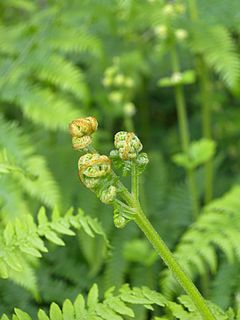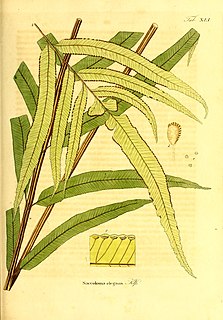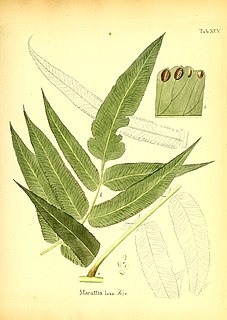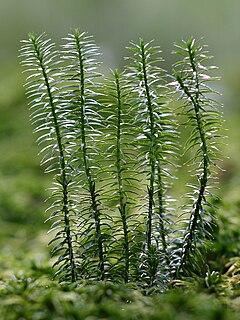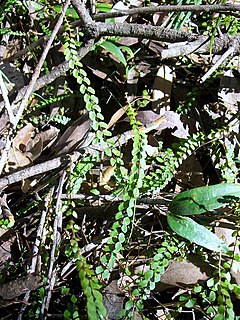| Psilotopsida | |
|---|---|
 | |
| Scientific classification | |
| Kingdom: | Plantae |
| Division: | Pteridophyta |
| Class: | Psilotopsida D. H. Scott |
| Orders & families | |
Psilotopsida is a class of ferns or fern-like plants, considered to be one of the three classes of eusporangiate ferns. [1] It should not be confused with the obsolete class Psilophytopsida. As circumscribed by Smith et al., 2006, [2] Psilotopsida contains two families, Psilotaceae and Ophioglossaceae, placed in orders Psilotales and Ophioglossales, respectively. [3] The affinities of these two groups have long been unclear and a close relationship between them has only recently been confirmed through molecular systematic studies. Some studies show that Psilotopsida is the sister-group to all other ferns (including Marattiaceae and Equisetaceae), [1] [4] but others indicate that Equisetaceae is more basal. [5]

A fern is a member of a group of vascular plants that reproduce via spores and have neither seeds nor flowers. They differ from mosses by being vascular, i.e., having specialized tissues that conduct water and nutrients and in having life cycles in which the sporophyte is the dominant phase. Ferns have complex leaves called megaphylls, that are more complex than the microphylls of clubmosses. Most ferns are leptosporangiate ferns, sometimes referred to as true ferns. They produce coiled fiddleheads that uncoil and expand into fronds. The group includes about 10,560 known extant species.

Eusporangiate ferns are vascular spore plants, whose sporangia arise from several epidermal cells and not from a single cell as in leptosporangiate ferns. Typically these ferns have reduced root systems and sporangia that produce large amounts of spores
Psilophytopsida is a now obsolete class containing one order, Psilophytales, which was previously used to classify a number of extinct plants which are now placed elsewhere. The class was established in 1917, under the name Psilophyta, with only three genera for a group of fossil plants from the Upper Silurian and Devonian periods which lack true roots and leaves, but have a vascular system within a branching cylindrical stem. The living Psilotaceae, the whisk-ferns, were sometimes added to the class, which was then usually called Psilopsida. This classification is no longer in use.
Psilotales have rhizoids instead of real roots, and the roots in Ophioglossales are lacking both root branches and root hairs. The gametophytes of both orders are heterotrophic and often subterranean, getting nutrients from mycorrhiza instead of performing photosynthesis, which happens exclusively in the sporophyte. [6]
Rhizoids are protuberances that extend from the lower epidermal cells of bryophytes and algae. They are similar in structure and function to the root hairs of vascular land plants. Similar structures are formed by some fungi. Rhizoids may be unicellular or multicellular. Roots are multicellular organs composed of multiple tissues that collectively carry out a common function.

A gametophyte is one of the two alternating phases in the life cycle of plants and algae. It is a haploid multicellular organism that develops from a haploid spore that has one set of chromosomes. The gametophyte is the sexual phase in the life cycle of plants and algae. It develops sex organs that produce gametes, haploid sex cells that participate in fertilization to form a diploid zygote which has a double set of chromosomes. Cell division of the zygote results in a new diploid multicellular organism, the second stage in the life cycle known as the sporophyte. The sporophyte can produce haploid spores by meiosis.

A mycorrhiza is a symbiotic association between a fungus and a plant. The term mycorrhiza refers to the role of the fungus in the plant's rhizosphere, its root system. Mycorrhizae play important roles in plant nutrition, soil biology and soil chemistry.







